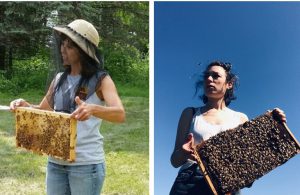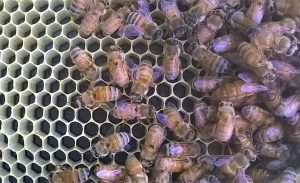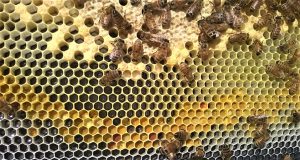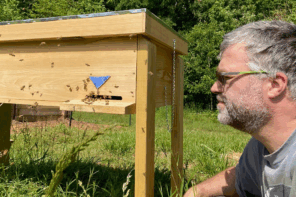
Authors
Becky Masterman led the UMN Bee Squad from 2013-2019. Bridget Mendel joined the Bee Squad in 2013 and has led the program since 2020. Photos of Becky (left) and Bridget (right) looking for their respective hives. If you would like to contact the authors with your egg hunting success stories or other thoughts, please send an email to mindingyourbeesandcues@gmail.com
Easter for Beekeepers
Becky Masterman & Bridget Mendel
For beekeepers checking the queen status of their hives, it’s one giant egg hunt from early Spring until the queen stops laying in early Fall. Unlike Easter eggs, honey bee eggs are absurdly small and white. But unlike the Easter bunny, the queen bee hides the eggs in plain sight: a healthy queen will lay eggs in the brood nest, in a uniform pattern, one after another. Finding eggs is the easiest way to confirm that the queen is alive and well.
Once your eyes get used to recognizing eggs in the brood nest, and once you become familiar with where the brood nest is found in the colony, then you can leave your inspections with queen status confidence. Lots of people are daunted by finding eggs. It’s hard at first! Things that can help you include: using black plastic foundation as opposed to yellow (the white eggs stick out more) wearing glasses, wearing just one contact lens (a strategy employed by Randy Oliver of Scientific Beekeeping), carrying a magnifying glass or cell phone (why not?), enlisting a sharp-sighted child, and making sure the sun is behind you to avoid a glare. For experienced beekeepers, finding eggs is second nature, like a musician picking up the patterns of a song.
Once you join the category of casually-confident egg-finder, you can while away the hours pondering the meaning of the egg, as we like to do. Below, we bring you some of our favorite egg facts, discovered just for you by scientists who like to study small things:
1.Honey bee eggs are small, but how small? Researchers at the University of North Carolina demonstrated both genetically based and environmental influences on the size of eggs laid by honey bee queens (Amiri et al. 2020). Not only did egg sizes vary based on the genetic lines of queens, but queens in different sized colonies laid different sized eggs, with the smaller eggs in the larger colonies. The authors hypothesized that investing in larger eggs occurred in smaller colonies to increase chances of brood survival in situations where brood care resources were limited.
2.And how long does the egg remain an egg? While the standard answer is that it takes three days for an egg to hatch, a laboratory experiment demonstrated considerable variation in hatch time based on queen source (Collins 2004). Eggs hatch as soon as 66 hours (2.75 days) from the time they were laid all the way up to 95 hours (almost four days).

Why can egg spotting be so difficult? Recently laid eggs are upright and harder to visualize. You can spot a few eggs in this photo along with the egg layer (queen).
Photo credit: Rebecca Masterman
3.And how does the egg hatch at whatever time it hatches? A research team from the American Natural Museum of History and the USDA explained the mechanical help larvae get from hatching spines and a proposed source of enzymes that break down the chorion (the fancy word for insect eggshell). These researchers used electron micrographs to examine egg hatching in numerous bee species (Rozen Jr. et al. 2017).
4.Laying fertilized (diploid) eggs is crucial for a queen to maintain a colony’s worker population. A study done down under investigated how much control a queen has over sperm release when fertilizing eggs. The results show that honey bee queens release a median of two sperm per egg for fertilization and this number decreases as queens age (Baer et al. 2016). According to this research, honey bee queens aren’t able to manipulate the use of the finite sperm supply stored in their spermatheca. Instead, the authors hypothesize that when the queen’s egg fertilization rate decreases (increased number of haploid or drone destined eggs in worker cells), it might be a signal to workers to rear her replacement (the process is known as queen supersedure). While this information might not directly impact your management decisions, it does provide an explanation for how workers might know when it is time to replace a queen.

Eggs are easiest to visualize when black foundation is used. Another clue to queen health is spotting
recently emerged larvae. White eggs that look like tiny grains of rice can be seen just above the pollen and below the larvae and sealed brood in this photo. Close to these eggs you can see small deposits of brood food deposited into cells with young larvae.
Photo credit: Rebecca Masterman
5.The term “brood pattern” describes how the brood is arranged in the colony and its quality is measured by the absence of empty cells. A queen with a good brood pattern is laying eggs closely together in the frames. A research study done by Lee et al. (2019) elegantly asks the question of whether brood pattern quality is attributed to the queen or the colony. Their data will make you think twice about replacing a queen because of a poor brood pattern. These researchers revealed that brood patterns can improve when you move poor brood pattern queens to colonies headed by queens with good patterns. Brood patterns decreased in quality for the good brood pattern queens that were moved to poor brood pattern colonies. This study suggests colony level control of rearing the eggs to adult bees, thus releasing some of the blame from queens and thus confusing beekeepers.
6.Understanding brood diseases is critical to the success of your beekeeping operation. Just because–or especially because–diseases are often asymptomatic until it’s too late, we all need to do our homework and be proactive with our management. The USDA has an easy to understand overview of brood diseases and apiary management. Vertical transmission of viruses can occur from a queen to an egg. Using tools that can detect virus mediated gene expression, research reported by Amiri et al. (2020) demonstrated that queen transmitted virus infections of deformed wing virus and sacbrood virus could be detected at the embryonic level. More research is needed to understand how this impacts the colony and ultimately management decisions.
Tune in next month for more egg-based information. Although they are small, there is much to cover when it comes to honey bee eggs.
References and Resources
Amiri, E., Le, K., Melendez, C. V., Strand, M. K., Tarpy, D. R., & Rueppell, O. (2020). Egg‐size plasticity in Apis mellifera: Honey bee queens alter egg size in response to both genetic and environmental factors. Journal of Evolutionary Biology, 33(4), 534–543.
Amiri, E., Herman, J. J., Strand, M. K., Tarpy, D. R., & Rueppell, O. (2020). Egg transcriptome profile responds to maternal virus infection in honey bees, Apis mellifera. Infection, Genetics & Evolution, 85, N.PAG.
Baer, B., Collins, J., Maalaps, K., & Boer, S. P. A. (2016). Sperm use economy of honey bee (Apis mellifera) queens. Ecology & Evolution (20457758), 6(9), 2877–2885.
Collins, A. M. (2004). Variation in Time of Egg Hatch by the Honey Bee, Apis mellifera (Hymenoptera: Apidae). Annals of the Entomological Society of America, 97(1), 140–146.
Lee KV, Goblirsch M, McDermott E, Tarpy DR, Spivak M. Is the Brood Pattern within a Honey Bee Colony a Reliable Indicator of Queen Quality? Insects. 2019 Jan 8;10(1):12. doi: 10.3390/insects10010012. PMID: 30626029; PMCID: PMC6359415.
Rozen Jr., J. G., Smith, C. S., & Cane, J. H. (2017). Survey of Hatching Spines of Bee Larvae Including Those of Apis mellifera (Hymenoptera: Apoidea). Journal of Insect Science, 17(4), 1–10.
USDA Brood Diseases Overview
https://www.ars.usda.gov/northeast-area/beltsville-md-barc/beltsville-agricultural-research-center/bee-research-laboratory/docs/precautions-against-the-spread-of-brood-diseases/
Acknowledgement
The authors would like to thank Dr. Marla Spivak for helpful edits and suggestions.









